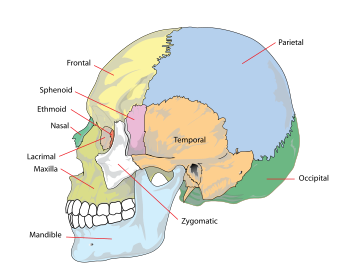Skull - Simple English Wikipedia, the free encyclopedia



A skull, or cranium, is a set of bones that make up the head of a vertebrate and keep in place all body parts in the head.[1] It supports the structures of the face and forms a protective cavity for the brain.[2]
As well as protecting the brain, the skull fixes the distance between the eyes and between the ears. This allows stereoscopic vision, and helps the brain judge direction and distance of sounds. In some animals, the skull also has a defensive function (e.g. horned ungulates). The frontal bone is where horns are mounted.[3][4]
The skull is made of a number of joined (fused) flat bones. In humans, the adult skull is normally made up of 28 bones.
Structure
[change | change source]Skulls can be classified based on fenestras which are window or opening in a skull. There are 5 types of fenestras which are:
- Antorbital fenestra
- Mandibular fenestra
- Quadratojugal fenestra
- Subsquamosal fenestra
- Temporal fenestra
References
[change | change source]- ↑ Cephalization definition from Encyclopædia Britannica
- ↑ Definition of skull from Merriam-Webster dictionary
- ↑ Romer, Alfred Sherwood; Parsons, Thomas S. (1977). The Vertebrate Body. Philadelphia, PA: Holt-Saunders International. pp. 173–177. ISBN 0-03-910284-X.
- ↑ skull rings
Other websites
[change | change source]- Skull Module (California State University Department of Anthology)
- Human skull base Archived 2017-05-23 at the Wayback Machine (in German)


 French
French Deutsch
Deutsch